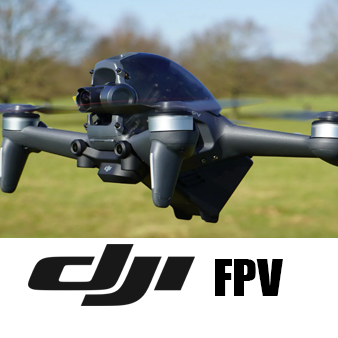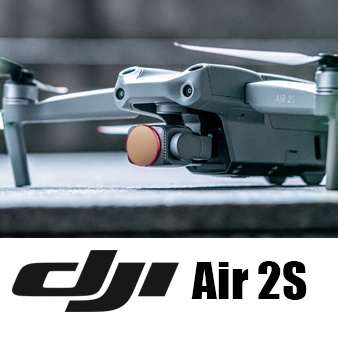

The DJI FPV vs. Air 2S debacle has been going on since DJI released the Air 2S. The FPV is an exceptional racing and photography drone. It perfectly balances maneuverability and speed and comes with a high-quality camera. It is the first of its kind, as many drones can only take cinema-level footage when they slow down and move steadily. The Air 2S has a better camera quality and is better suited for high-end photography and video. So, which is better?
Choosing between DJI FPV and Air 2S should be a breeze if you know what you need from a drone and what each model offers. This comparison guide closely looks at the drones’ features and capabilities to help you make an informed choice.
| DJI FPV | DJI Air 2S | |
| Dimensions | 255×312×127 mm (with propellers) | 180×97×77 mm (folded); 183×253×77 mm (unfolded) |
| Weight | 795 g | 595 g |
| Flight time | 20 mins | 31 min |
| Flight Distance | 16.8 km | 18.5 km |
| Max. speed | 38 m/s | 19 m/s |
| Wind resistance | 39-49 kph (25-31 mph) | 10.7 m/s |
| Photo resolution | 12 MP | 20 MP |
| Video resolution | 4K | 5.4K |
Here is a side-by-side comparison of the two famous DJI drones; DJI FPV and Mavic Air 2S. Trusted Source DJI Air 2S Take a Closer Look store.dji.com You can get both drones from the DJI store or Amazon.
Regarding photography and video resolution, the Air 2S is the clear winner. It has a higher resolution of 5472 x 3078 at 30fps than the Air 2S, which has 3840 x 2160 at 60fps. Many theatrical movies are still shot at 24 fps. If you wanted to shoot a movie at 24 fps, the Air 2S would be your best bet. The Air 2S also performs better when it comes to the bitrate of videos with 150 Mbit/s. The FPV has 120Mbit/s.
The Air 2S lets you capture up to 5.4K video with an impressive 1-inch CMOS sensor. With such a large image sensor, you can capture incredible footage with detail and depth of color to view on large screens. Moreover, the HDR technology combines multiple shots for better depth in low-light conditions.
The Air 2S has 20 megapixels stills, while the FPV has 12 Megapixels. Besides the HDR function, it also has continuous shooting, RAW photo format, Panorama, and Wide angle features. The Air 2S is the clear winner in this category.
The FPV and Air 2S are specifically designed for two different reasons, thus, have different stabilization. The FPV has a single-axis gimbal with an electronic roll axis. On the other hand, the Air 2S has a 3-axis gimbal. Although the DJI FPV has an electronic roll axis, the Air 2S will give you better photos and videos with great control of framing options.
The FPV’s electronic roll axis will give relatively smooth footage, but you won’t have control over the direction the camera is pointing. Therefore, if your primary need for a drone is taking photos and videos, the Air 2S is a better pick.
The DJI Air 2S has a longer flight time because of its larger battery capacity. In good weather conditions, the Air 2S will manage up to 31 minutes which is way longer than FPV’s 20 minutes. 31 minutes equate to a distance of about 18 km, and 20 minutes is about 16 km, which is decent for a single charge.
Both drones have removable batteries. You can buy an extra battery to increase the flight time and distance, even though you must land the drone to change the battery.
This is where the FPV shines. It is a racing drone with a unique design meant for speed and agility. The FPV can fly at a flash speed of 140 km per hour, which is way faster than Air 2S at 68.4 km per hour. FPV also wins in the climbing and descent speed categories. It climbs at 15 meters per second (m/s), while the Air 2S climbs at 6 meters per second. The FPV descends at 10 m/s, and the Air 2S descends at 6 m/s.
Further, since the FPV has extra motor power, it has better wind resistance and can efficiently handle high-speed winds.
Sensors are a critical part of a drone as they help you keep it safe when in flight. According to an article by MDPI Trusted Source Sensors | Free Full-Text | Sensors and Measurements for Unmanned Systems: An Overview The advance of technology has enabled the development of unmanned systems/vehicles used in the air, on the ground or on/in the water. The application range for these systems is continuously increasing, and unmanned platforms continue to be the subject of numerous studies and research contributions. www.mdpi.com , the environment in which drones operate can affect their mission results significantly. When flying the drone, the detecting system will save you from crashing into obstacles like trees, buildings, and people. It is especially important for a beginner drone pilot. That said, the Mavic Air 2S has a better obstacle avoidance system that will keep your drone safe when flying in complex 3D system environments.
The DJI FPV would be less fun to fly if it had fewer sensors. The drone’s sense of fun is in getting too close to obstacles and passing them at top speed when viewing through the first-person view stream. The FPV has a downward pointing LED, return home, and auto-landing features for safety.
The DJI FPV has multiple intelligent features and a wide range of flying modes. First off, it comes with goggles that allow you to be immersed completely in the flight. The goggles have a wide view of up to 150 degrees and high-definition video transmission at an impressive speed of 120 frames per second. The drone’s modes include;
N mode: This is the standard stabilized mode that many DJI drone pilots use. The drone can normally fly in this mode when you take your hands off the stick. In this mode you have all the traditional drone flight control, including obstacle sensing.
S Mode: This is like a hybrid flight mode that combines simple drone flight controls and the freedom of flying manually. On the FPV, S mode is more of a training mode for anyone looking to train for racing. S mode is faster than N mode, but you can control the drone’s tilt and other functions within safe limits.
M Mode: This is a flight mode for experienced drone pilots. It comes in two variants; one is full manual operation and the other places a limit on the tilt.
The Air 2S has unmatched intelligent flight modes. DJI has upgraded the model’s intelligent flight so much that the modes have new names. The modes include
Focus Track mode: This is for flying manually. It has three sub-modes that allows you to get phenomenal shots whether your subject is stationery or moving. The three sub-modes are spotlight 2.0 and active tracks. When flying in the Focus track mode, you have to be keen not to hit obstacles because the side sensors don’t work in this mode.
Hyperlapse: This mode allows you to capture videos that look sped up. Drone pilots often achieve this by editing the videos on a software, but the videos usually look choppy and unprofessional. Hyperlapse has sub modes including, free mode, circle mode and course lock.
Mastershots: This is a program that runs a programmed flight pattern around your subject, takes videos and stills then puts together a finished product.
Quickshots: This is an automated flight program that allows you to center and draw a box around your subject. When you click on one of the six patterns and push the start button, the drone will fly in the pattern and return to the starting position while recording a video.
In sum, the DJI Mavic Air 2S is the clear winner in this category. It has more intelligent features and modes for taking high-quality videos and pictures.
The Mavic Air 2S has a more compact and portable build. You can easily fold it into a smaller form and bring it with you anywhere. It weighs a mere 21 oz and measures 7.1 x 3 x 3.8in when folded and 7.2 x 3 x 10in. when unfolded. The extra unfolded size is the extended propeller arms, otherwise, the drone’s body is incredibly small in both configurations.
The DJI FPV, on the other hand, is not the best portable drone out there. It has a hefty battery that makes it slightly heavier than most FPV drones. Plus, you would have to carry it with the goggles which make it even less portable. Taking off its propellers may help, but it still wouldn’t be as light as the Air 2S.
Very few drones have a storage feature. However, it’s no surprise that both FPV and Air 2S have a memory card slot. Both slots have flexible capacities so you can have the largest storage capacity for convenience.
FPV means first-person view. According to CNET Trusted Source My first DJI FPV drone flight: 5 things I've learned - CNET DJI’s new FPV drone is amazing, but there’s a lot to learn. Here’s what you need to know. www.cnet.com , DJI is the first brand to offer a ready to fly FPV system. The FPV system allows you to see everything from the drone’s point of view. It is a lot more fun with the VR goggles. Both DJI FPV and Mavic Air 2S have the FPV function.
According to an article by Science Direct Science Direct Trusted Source Drone A drone is really just a remote control flying device. Where remote control devices have been around for decades, it has become popular to introduce intelligence into the device allowing them to be controlled with smartphones or other mobile devices. www.sciencedirect.com drones are basically remote control flying devices. Therefore, the remote control is a critical part worth considering when choosing a drone. The DJI FPV comes with a remote control that features an antenna for efficient communication with your fast-moving drone. It does not feature an onboard screen but has an incredibly long battery life of 9 hours. Such a long battery life is hard to come by for drone remote controls. Best of all, the drone has an optional DJI motion controller that allows you to control the drone with hand motions.
The Air 2S has a straightforward remote control that allows you to add a screen via your smart phone. Its battery lifetime is 6 hours which is pretty decent.
The DJI FPV and Air 2S are the most popular DJI drones with the FPV function. The FPV is a unique drone with incredible features. It is a fantastic choice for drone racing and high-speed photography. Its flight time is also decent. The Air 2S is one of the best DJI drones on the market. It features a high-end camera, a longer flight time of 34 minutes and a decent flight speed. Which is the better drone?
From our detailed DJI FPV vs. Air 2S comparison guide, it is clear that the Air 2S is the best option if you need a drone for high-end photography and cinema-level videos. DJI FPV offers the best FPV experience. If you need a racing drone it is the better option.